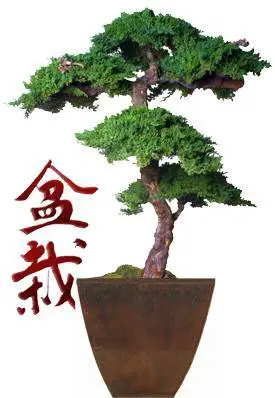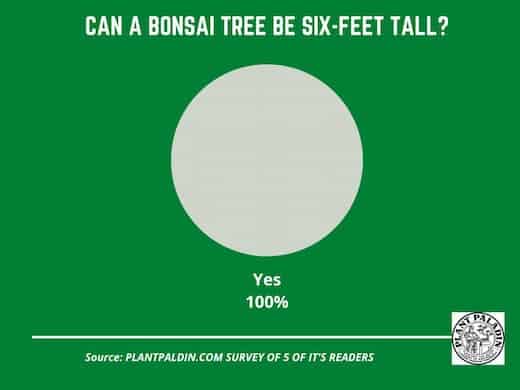This website is supported by its readers. If you click one of my links I may earn a commission. I am also a participant in the Amazon affiliates program and I will also earn a commission from qualified purchases.
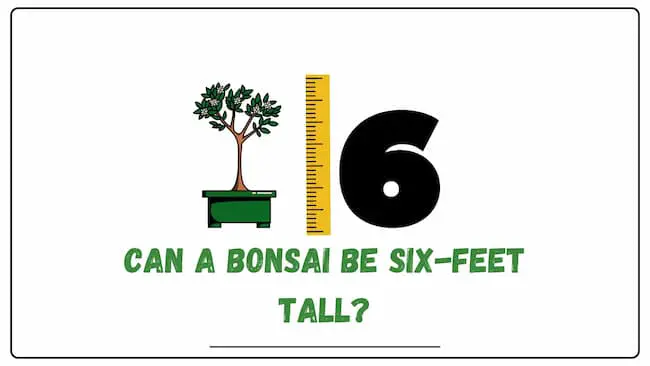
One of the things that I love about bonsai is how you replicate and create miniature versions of popular trees. That said, most bonsai trees are at most 30cm tall. Can a bonsai be 6 feet tall?
Bonsai trees can be six feet tall. Six feet tall bonsai trees will typically fall into the imperial bonsai category – the tallest size classification for bonsai. Six feet tall bonsai trees are amongst the most expensive bonsai trees.
So is there a history of six-foot-tall bonsai trees? And what are the advantages and disadvantages of six-foot tal bonsai? Keep reading to find out more!
Just a quick heads up, over the past three years of running Plantpaladin, hundreds of people have asked for product recommendations. As such, You can find my favorite indoor bonsai tree here (link takes you to Bonsaiboy), my favorite outdoor bonsai tree (link takes you to Bonsaiboy), or have a look at all the products I recommend here.
Can a bonsai be 6 feet tall?
To get to the bottom of “Can a bonsai be 6 feet tall,” I contacted a few bonsai experts, visited my local botanical gardens, and reached out to 5 plant paladin readers.
All to ensure that this post was the most up-to-date and accurate possible.
To summarize:
- Bonsai trees can indeed be six feet tall.
- While they are less common than their smaller counterparts, you can purchase six-foot bonsai trees from specialty bonsai nurseries.
- Fast-growing or outdoor bonsai species will work best for 6 feet bonsai trees, such as cedarwood or pine varieties.
- Bonsai trees that are six feet fall into the imperial bonsai size classification.
- Imperial-sized bonsai are trees that are between 152 to 203cm tall.
- Imperial bonsai trees are amongst the tallest a bonsai tree can be. As a result of the size and the time it takes to grow a bonsai this tall, they are amongst the most expensive trees out there.
- The main benefit to owning a six-foot bonsai tree is that they are amongst the most aesthetically pleasing trees you can purchase if trained correctly.
- This means that the resale value of these trees is considerable.
- The main disadvantage, however, is the amount of space and time required to grow the bonsai tree effectively.
Now this is quite a lot of information, so let’s break down these points in more detail.
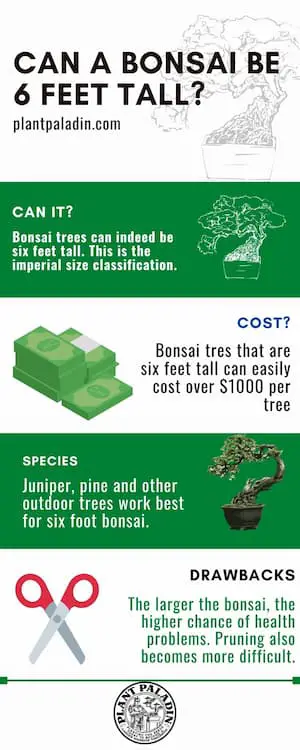
How to grow a bonsai to 6 feet tall?
So naturally, many of you reading this post are thinking about purchasing or growing your bonsai tree to size feet tall.
The good news is that most of the skills needed to grow a bonsai to 6 feet tall are the same as growing a bonsai tree overall – you can read more about that here.
The few key differences, however, would be as follows:
Choose the correct species.
First, the most significant recommendation I would have to make the whole process easier is selecting the right subs-species.
Avoid slow-growing indoor bonsai tree species such as Ficus or Jade if you want your tree to grow to six feet.
Even if you grow these trees in perfect conditions, they add only between one and five inches of growth yearly.
Instead, opt for taller, faster-growing trees like oak, willow, pine, or other outdoor trees.
Choose the right pot.
While most bonsai are grown in compact spaces, consider investing in a larger, deeper pot in the first few years of growing your tree.
This will enable the tree to grow faster than it would be you to grow in a traditional shallow bonsai pot.
Let it grow for the first seven years.
I would then let your bonsai tree grow unpruned for the first seven years.
It can be very tempting to cut back or prune the tree, but if you want to grow a six-foot bonsai tree in the shortest time possible for the first seven years, just let it grow out.
You can even plant the tree outdoors in the ground to further speed up the growth.
Look after the tree.
During these first seven years, provide ample care to your bonsai tree.
Ensure it is not overwatered or waterlogged.
Winterize your tree if it belongs to species that needs watering.
Provide ample sunlight (most bonsai trees need between 6 to 8 hours of direct sunlight daily).
Finally, ensure you use the correct potting soil for your tree with a balanced N-P-K ratio.
Start training around the 7-year mark.
After seven years, your bonsai tree should have gained significant height.
At this point, I would start training your tree.
Consider developing the trunk to create a thick wide masculine trunk.
Prune back the branches to create the shape of your tree.
Defoliate the leaves to create more ramifications or new leaf growth.
Finally, wire the tree into the position you want your tree to grow in.
Be patient
The final recommendation is just to be patient.
Growing a bonsai tree to six feet tall is a challenging feat, and the main reason why most people give up on growing these is they need more patience.
Treat this then as a decade-long endeavor, significantly if you are growing entirely from scratch.
Learn to enjoy the process, and with persistence, you will have a six feet tall bonsai tree in no time.
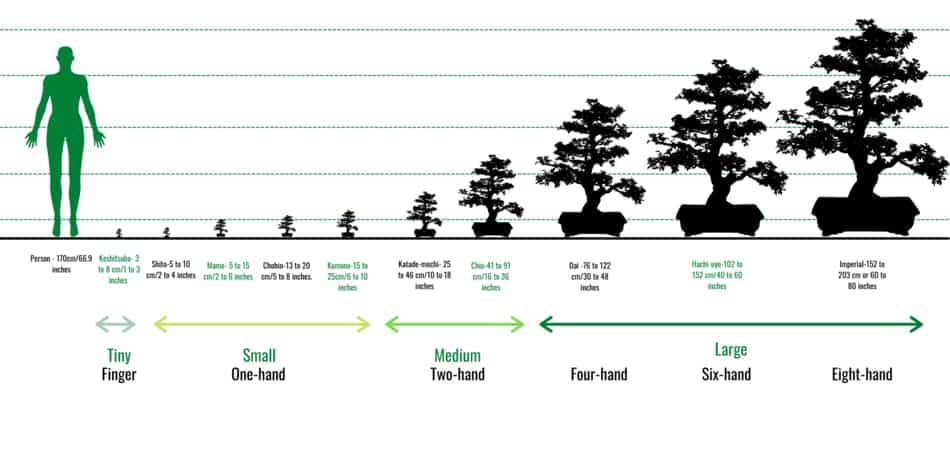
How long does it take to grow a bonsai to 6 feet tall?
Growing a bonsai tree to 6 feet tall will take over ten years, even in the fastest-growing species. Most bonsai trees will only reach this height if cared for correctly for 15 to 20 years. Invest in fast-growing outdoor bonsai species like pine or juniper for best results.
How expensive are six-foot-tall bonsai trees?
Now if growing a six-foot-tall bonsai tree from scratch is too time-consuming, another option would be to purchase a pre-existing tree.
So how expensive are six-foot bonsai trees?
The average price of a six-foot-tall bonsai tree is 1384.80 (£1107.84). This is much more expensive than a regular-sized bonsai tree, which typically retail for between $30 and $150.
As such, the resale value of these trees is massive.
To help, I compared a few bonsai trees below.
Height
Brand
Cost $
Cost £
Six feet
Forever Green Heart
$1,499.00
£1,873.75
Six feet
Bonsai Boy
$1,399.00
£1,748.75
Six feet
Topiary Plants
$1,250.00
£1,562.50
Six feet
Bonsai tree Gardner
$999.00
£1,248.75
Six feet
Artificial plants and trees
$1,777.00
£2,221.25
Where can I buy a six-foot bonsai tree?
I recommend purchasing a six-foot-tall bonsai tree from a reputable bonsai retailer instead of sites like Amazon and eBay from unknown brands, mainly because these are significant investment pieces.
As such, my recommendation for a six-foot-tall bonsai tree would have to be Bonsai Boys six feet tall bonsai which you can purchase here (the link takes you to Bonsai Boys website)
Not only are they the market leader in a range of bonsai products, the small family-run business means that the tree has the love and care needed to grow to over six feet tall.
This tree is a Juniper meaning it can be kept outdoors year-round, with the cold not impacting this tree at all.
On top of this, the tree has a beautiful design meaning all you need to do is find a suitable space to keep this tree.
History of six-foot-tall bonsai trees?
So while it might be uncommon for us bonsai hobbyists, six-foot bonsai trees are relatively well-known in the bonsai world.
In ancient times, imperial-sized six feet bonsai trees were only reserved for Japanese and Chinese emperors, who would use the giant trees to stand out as a sign of wealth.
As such, this is where the term imperial bonsai originated from.
Six-foot bonsai trees are commonly displayed at conventions and competitions in the far east.
What are the advantages of six-foot bonsai trees?
So having a bonsai tree that is six-foot tall has many advantages. This includes:
- Impressive aesthetic appeal: A six-foot bonsai tree can be a striking centerpiece or focal point in a garden or indoor space. Its size and stature can command attention and create a unique visual impact.
- Sense of maturity and grandeur: A larger bonsai tree can convey a sense of age, strength, and beauty. It may evoke a feeling of reverence and admiration due to its imposing presence.
- Increased artistic possibilities: With a larger canvas to work with, you have more flexibility in shaping and styling the tree. The branches, trunk, and foliage can be more intricately designed, allowing for more complex and dramatic bonsai compositions.
Disadvantages of six-foot bonsai trees?
Like anything in life, six-foot bonsai trees will also have a few significant disadvantages too, including:
- Challenging maintenance: Larger bonsai trees require more effort and resources to maintain. They often have a higher demand for water, nutrients, and sunlight. Pruning, wiring, and general care become more time-consuming and physically demanding.
- Limited portability: Moving or transporting a six-foot bonsai tree can be difficult due to its size and weight. It may require multiple people or specialized equipment to safely handle and transport the tree.
- Higher risk of health issues: Large bonsai trees may be more susceptible to specific health problems, such as root rot or pest infestations. Their size can make it harder to spot and address these issues promptly, potentially leading to more significant damage or tree loss.
- Space limitations: Accommodating a six-foot bonsai tree requires a significant amount of space, both vertically and horizontally. Only some people have space in their garden or home to comfortably house such a large tree.
- Longer development time: Growing a bonsai tree to such a substantial size can take many years, if not decades, of careful nurturing. It demands unwavering patience, dedication, and a long-term commitment to the tree’s care.
How tall can a bonsai grow?
The tallest a bonsai tree will grow is 60 to 80 inches or 152 to 203cm. This height range is the imperial bonsai size classification, the tallest size classification bonsai trees call fall into. Bonsai trees grown taller are seen as regular trees by bonsai enthusiasts.
What is the normal size of a bonsai?
The most common size for bonsai trees is between 25 to 40 cm tall. This will fall into the one or two-handed bonsai size category. These bonsai trees are widespread as they are easy to care for at this height and can be easily distributed without damaging the tree.
Can a bonsai tree be six feet tall? – Survey results
Finally, I asked five plant paladin readers/experts if bonsai trees can be six feet tall – here were the results:
My top picks for the gear you will need!
So like I mentioned earlier, over the past three years of running PlantPaladin, hundreds of people have asked me for my recommendations on the best bonsai gear on the market.
Having spent thousands of dollars on bonsai items these past few years and tested at least 100 bonsai-specific products, I’ve listed my favorite products below – All of which I highly recommend and think you can get great value.
They can purchase directly by clicking the link to take them to Amazon.
Bonsai Tool Set: One of the significant challenges I’ve had is finding a toolset that was not only durable but didn’t break the bank. SOLIGT has recently developed a fantastic bonsai tool set that covers all the tools you need to trim, prune, and repot your trees. – You can grab it here.
Complete Bonsai Set: Many of you will want to grow your bonsai trees entirely from scratch, but finding the varicose seeds, pots, and other items in one place can be challenging. Leaves and Sole then have created a complete bonsai set that I’ve personally used that ticks all the boxes. You can grab it here.
Bonsai wire: The number of times I’ve run out of wire for my bonsai or purchased cheap bonsai wire that doesn’t do the job is embarrassing for me to admit. After a lot of trial and error, I found that using Hotop’s aluminum bonsai wire is one of the best options on the market. This can easily be used for both indoor and outdoor bonsai. You can grab it here.
This post was written by Fehed Nicass, who has been passionate about bonsai and gardening for over three years.

